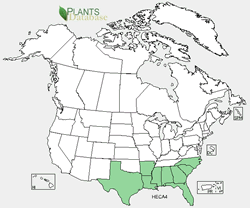Plant of the Week
 Helianthemum carolinianum range map. USDA PLANTS Database.
Helianthemum carolinianum range map. USDA PLANTS Database.
 Carolina rockrose chasmogamous flowers showing numerous stamens and 3-parted style. Photo by David Moore.
Carolina rockrose chasmogamous flowers showing numerous stamens and 3-parted style. Photo by David Moore.
 Carolina rockrose plants, Grant Parish, Louisiana. Photo by David Moore.
Carolina rockrose plants, Grant Parish, Louisiana. Photo by David Moore.
Carolina Rockrose (Helianthemum carolinianum (Walter) Michx.)
By David Moore
Carolina rockrose is a showy, drought-tolerant, perennial member of the Cistaceae family. It occurs in sandy fields, cemeteries, along roadsides and in open pine woods from Texas east through the southeastern U.S. and up to North Carolina.
As with other members of this genus, the “normal” (chasmogamous) flowers have five bright-yellow petals, numerous stamens and a 3-lobed style. These “normal”, cross-pollinating flowers are produced earlier in the growing season (March in central Louisiana) and occur singly or in small clusters toward the stem tips. Lateral branches elongate at or after the first round of flowering and produce self-pollinating (cleistogamous) flowers that appear later in the season, usually June in central Louisiana.
The main advantage of cleistogamy is that less energy is needed to produce seeds because “normal” flower actions (production of nectar, petals, and pollen) are not needed. This can prove useful for seed production on unfavorable sites (dry, sandy soil) or adverse conditions (hot, dry summers). The disadvantage of cleistogamy is the lack of sexual reproduction, which can lead to inbreeding depression or the loss of adaption to additional environmental constraints. Peanuts and violets are some other plants that have self-pollinating flowers.
Carolina rockrose is not a strong competitor, but it has developed a unique survival strategy that involves its fire tolerance. The seeds are sown in the soil during the growing season, but they don't germinate in the next season. Since the hard seed coat is impermeable to water, the seeds remain soil-dormant for a long period of time. Together with their small seed size, seed-dormancy allows populations of Carolina rockrose to establish a large seed bank. After a fire has moved through an area, the seed coat softens or cracks due to the heat of the fire, and the surviving seeds germinate shortly after. This mechanism allows the Carolina rockrose (and other members of the Cistaceae family) to produce a large number of young plants simultaneously and at the right time, thus helping it obtain an important advantage over other plants in the process of repopulating the area. The lack of modern wildfires is probably one reason why Carolina rockrose is not seen in great abundance these days in the southeastern United States.

